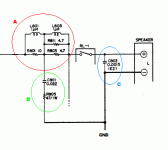Greetings.
The following figure represents the late output of an amplifier (circuitry right before the speaker, after the amplification stage).
Can you briefly explain what are the rolls of blocks A, B and C?
Can I eliminate any of these three blocks (or all of them), thus obtaining a more transparent sound?
Thanks and regards!
The following figure represents the late output of an amplifier (circuitry right before the speaker, after the amplification stage).
Can you briefly explain what are the rolls of blocks A, B and C?
Can I eliminate any of these three blocks (or all of them), thus obtaining a more transparent sound?
Thanks and regards!
Attachments
Sony said:
Can you briefly explain what are the rolls of blocks A, B and C?
A is a series Zobel network and is a protection against high capacitive load , as some audiophile fancy cables.
B is a parallel Zobel network and is needed for stability of the amp in case of no load or a inductive one ,like a dynamic speaker.
C is a small capacitor that probably is only purpose is for compatibility with Electromagnetic Compatibility Rules in Europe.
So ,if you take A out of circuit you can not use high capacity cables...

B must be always in circuit for amp stability.
C you can take out and try a listening... 😎
Greetings from Aveiro... 😉
All right!!! Thanks for the superb answer! 🙂
Damn complexity! Can't live with it or without it... 😎
Greetings from Queijas!
Damn complexity! Can't live with it or without it... 😎
Greetings from Queijas!
Hi,
I can see two reasons for keeping C803.
1.) to attenuate interference coming from the speaker leads back into the inverting input of the amplifier.
2.) to reduce the back EMF effect of the speaker creating a spark across the relay contacts, probably to extend it's life.
The Thiele Network is a little more complex than usually seen.
But the designer must have thought it important enough to have added these components to his completed circuit. I agree with Tube that you risk instability if you omit any part of the existing Thiele network.
I can see two reasons for keeping C803.
1.) to attenuate interference coming from the speaker leads back into the inverting input of the amplifier.
2.) to reduce the back EMF effect of the speaker creating a spark across the relay contacts, probably to extend it's life.
The Thiele Network is a little more complex than usually seen.
But the designer must have thought it important enough to have added these components to his completed circuit. I agree with Tube that you risk instability if you omit any part of the existing Thiele network.
Thanks Andrew!
So, in conclusion, this little circuit is perfect! or untouchable, at least.
or untouchable, at least.
To improve the sound I must start looking to the main circuits... where the conclusion will probably be the same... I start to feel the ways to improve this amp will be restricted to using better parts (wire, connectors, etc.), but that won't make a spectacular difference.
So, in conclusion, this little circuit is perfect!
 or untouchable, at least.
or untouchable, at least.To improve the sound I must start looking to the main circuits... where the conclusion will probably be the same... I start to feel the ways to improve this amp will be restricted to using better parts (wire, connectors, etc.), but that won't make a spectacular difference.
while A and B don't have a direct effect on the sound, they do have a slight effect on the amp's output impedance, mostly at frequencies above 10khz. these damping networks are important. i recently had an amp come in for repair with the complaint that it was smoking, and cutting out the protection relay. turns out that the only damage was the zobel networks were fried in both channels. the customer had attached the amplifier to speaker lines in a very long (and very capacitive) snake. i told the customer to try another amp of different design, since this amp would oscillate again if connected to that snake. if the zobel networks had not shunted the oscillation in that amp, the output transistors probably would have "melted down".
in a capacitive load with oscillation, all of the energy is "reflected" back into the output stage, and the transistors must dissipate all of the heat. the zobel network dissipates some of that energy through the resistor, reducing the stress on the transistors.
in a capacitive load with oscillation, all of the energy is "reflected" back into the output stage, and the transistors must dissipate all of the heat. the zobel network dissipates some of that energy through the resistor, reducing the stress on the transistors.
- Status
- Not open for further replies.
